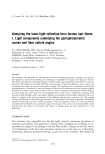USE OF DEOFIX TM IN DEODORANT PRODUCTS 261 succeed. For example, complexation of iron by EDTA may actually enhance the ability of iron to catalyze free radical formation, while complexation of iron with Deferoxamine has been shown to block free radical generation (25). Deofix TM is even 103 times more potent than Deferoxamine. We believe that the antioxidant activity of Deofix TM, as demonstrated in the experi- ments on the coupled oxidation of carotene and linoleic acid, is related to its strong chelating action on first transition series ions. The resistance to oxidation and reduction of Deofix's TM, as measured by cyclic voltametry, supports this conclusion by demon- strating that it is not working as a more classical antioxidant. REFERENCES (1) (2) (3) (4) (5) (6) (7) (8) (9) (lO) (11) (12) (13) (14) (15) (16) (17) (18) (19) (20) (21) (22) (23) (24) (25) E. P. Seitz and D. I. Richardson, Deodorant ingredients, Cosmet. Sci. Technol. Ser., 7, 345-390 (1988). Federal Register, 37, 160, 219 (January 7, 1972). S. A. Makin and M. R. Lowry, "Deodorant Ingredients," in Antiperspirants & Deodorants, 2nd ed., K. Laden, Ed. (Marcel Dekker, New York, 1999). H. S. Winchell et. al., U.S. Patent 6,264,966 B1 (july 24, 2001). Complexx R&D Services Ltd., Tirat Carmel, Israel (unpublished results). T. E. Furia and A. G. Schenkel, 2,4,4'-trichloro-2'hydroxydiphenyl ether A new broad spectrum bacteriostat, Soap Chern. Specialties, 44, 131-138 (1968). W.A. Vischer and J. Regos, Antimicrobial spectrum of triclosan, a broad-spectrum antimicrobial agent for topical application, Zbl. Bakt. Hyg. I Abt. Orig. A, 226, 376-389 (1974). J. Regos and H. R. Hitz, Investigations on the mode of action of triclosan, a broad-spectrum anti- microbial agent, Zbl. Bakt. Hyg. 1 Abt. Orig. A, 226, 390-401 (1974). J. E. Wild and L. P. Oddo, "Clinical Evaluation of Antiperspirants and Deodorants," in Antiperspirants & Deodorants, 2nd ed., K. Laden, Ed. (Marcel Dekker, New York, 1999). G.J. Marco, Rapid method for evaluation of antioxidants, J. Am. Oil Chern. Soc., 45, 594 (1968). U. Cogan and I. Neeman, Department of Food Engineering and Biotechnology, Technion-Israel Institute of Technology, Haifa, Israel (unpublished results). S. Licht, Department of Chemistry, Technion-Israel Institute of Technology, Haifa, Israel (unpublished results). M. R. Grever, S. A. Schepartz, and B. A. Chabner, National Cancer Institute Cancer Drug and De- velopment Program, Seminars in Oncology, 19, 622-638 (1992). V.L. Narayanan, Drug Synthesis and Chemistry Branch, National Cancer Institute, Bethesda, MD (unpublished results). E. Ben Porat, Virology Laboratory, Rambam Medical Center, Haifa, Israel (unpublished results). R. Koren, Felsenstein Medical Research Center, Rabin Medical Center, Beilinson Campus, Petah Tikva, Israel (unpublished results). S. Ulitzur, Bioluminescence test for genotoxic agents, Meth. Enzyrnol., 133, 264 (1986). J. A. Killian and F. P. Panzarella, Comparative studies of samples of perspiration collected from clean and unclean skin of human subjects, Proc. Sci. Sect. Toilet Goo& Assoc., 7, 3-11 (1947). W. B. Shelley, Apocrine sweat, J. Invest. Dermatol., 17, 255 (1951). J.J. Leyden et. aL, Skin microflora, J. Invest. Dermatol., 88, 65s-72s (1987). G. M. Baillely and R. G. Hall, WO Patent 97/02010 (1997). R. Osberghaus, D.E. Patent 2826759 (1979). R. Osberghaus, D.E. Patent 78/2826757 (1979). R. Osberghaus, D.E. Patent 2826758 (1979). J. B. Smith, J. C. Cusamano, and C. F. Babbs, Quantitative effects of iron chelators on hydroxyl radical production by the superoxide-driven Fenton reaction, Free Rad. Res. Cornrns., 8, 101-106 (1990).
j. Cosmet. Sci., 54, 263-270 (May/June 2003) The hair strand testA new method for testing antifungal effects of antidandruff preparations PETER MAYSER, HORST ARGEMBEAUX, and FRANK RIPPKE, Zentrum fiir Dermatologie und Andrologie der Justus-Liebig-Universit•it Giefien, Gaffkystr. 14, 35385 Giefien (P.M.), and Beiersdorf AG, Hamburg (H.A., F.R.), Germany. Accepted for publication August 19, 2002. Parts of this manuscript were presented at the 35th Annual Meeting of the Deutschsprachige Mykologische GesellschaJg, Marburg, Germany, September 13-15, 2001. Synopsis Seborrheic dermatitis and its minimal variant, dandruff (pityriasis simplex capillitii), are among the most frequent diseases caused by Malassezia (M.) yeasts. Treatment studies have shown that antimycotics achieve clinical improvement, while recolonization leads to recurrent symptoms. Among the antimycotics used are azoles, hydroxypyridones, and various agents such as zinc pyrithione, tar, and selenium disulfide. However, comparative efficacy studies in vitro should not only consider the minimal inhibitory concentrations against Malassezia yeasts but also the bioavailability of the individual substances with regard to hair and scalp. By means of a new method, the hair strand test, hairs from ten volunteers were subjected to standardized 5-min incubation with different shampoo formulations. Thereafter they were rinsed with running water for 1 min and dried. Two hundred each of these hairs (length 1 cm) were given into a medium (olive oi! on selective agar for pathogenic fungi) inoculated with M. sympodialis or M. globosa (5 x 103 CFU/lal), and the influence on growth was semiquantitatively determined over a period of up to 18 days. According to preliminary results, 1% climbazole proved to be particularly effective. The hair strand test, which can also be performed ex vivo, is a new method to find out whether antimycotic agents bind differently to the hair substance and, via a depot effect, may influence the growth of Malassezia yeasts and thus affect dandruff. This allows conclusions about the efficacy of antidandruff formulations. INTRODUCTION Yeasts of the genus Malassezia (M.) are part of the human microflora and that of several homeotherms (1,2). As their growth depends on an exogenous lipid source, they are primarily found in seborrheic areas that are rich in sebaceous glands. Seven species are currently differentiated: M. furfur, M. pachydermatis, M. sympodialis, M. globosa, M. obtusa, M. restricta and M. slooffiae (3,4). Initial epidemiological studies have shown that M. sympodialis and M. globosa are among the most frequent species on human skin (1-4). Address all correspondence to Peter Mayser. 263
Purchased for the exclusive use of nofirst nolast (unknown) From: SCC Media Library & Resource Center (library.scconline.org)


























































































